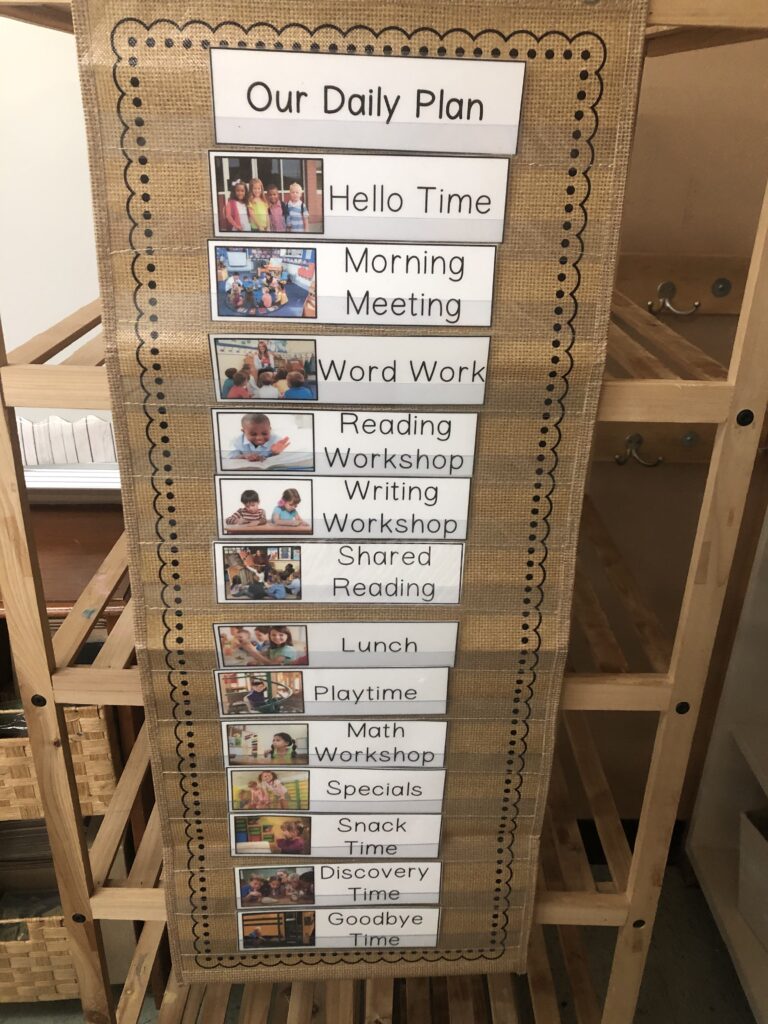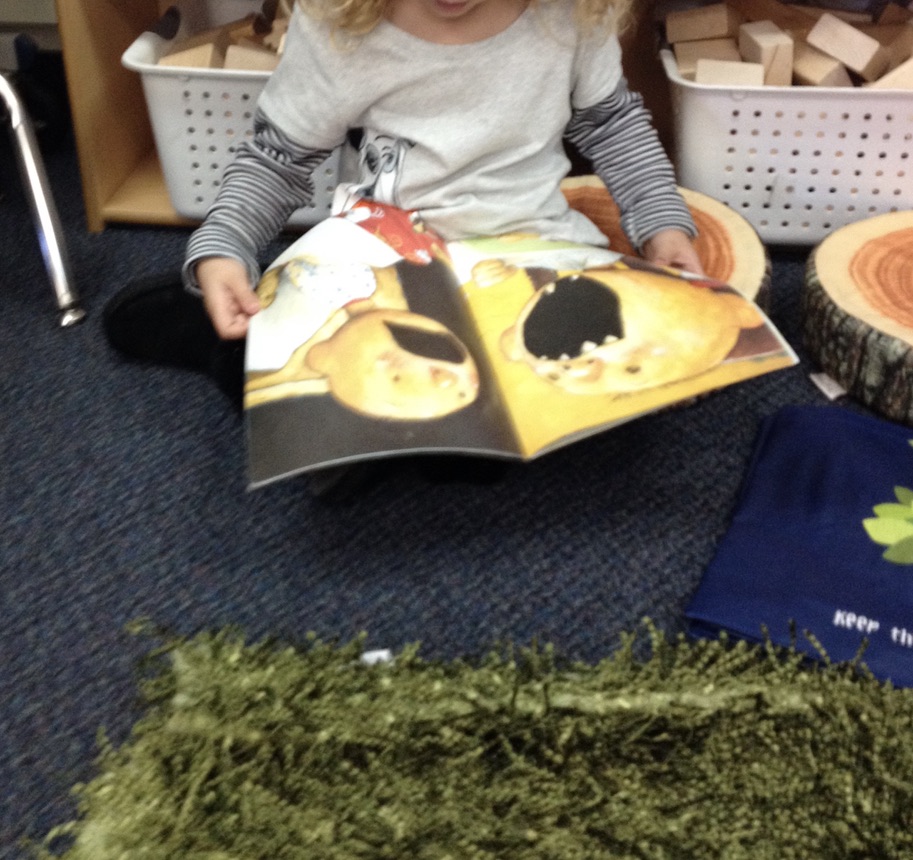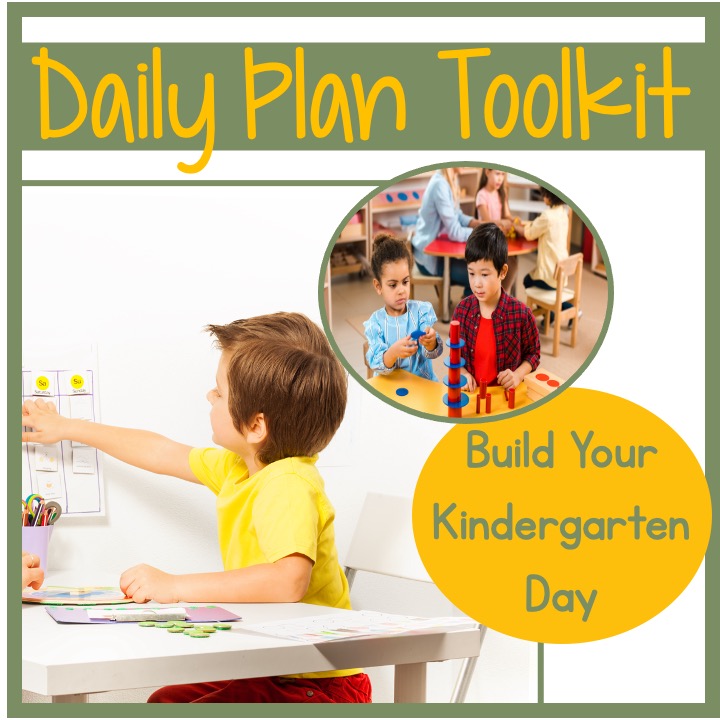Inside: Discover how to look more closely at your kindergarten schedule and balance the rhythm of your day so it flows more smoothly. And don’t forget to download your free Daily Plan Toolkit to help you plan your own kindergarten day!
Checking Your Rhythm
Posted on the wall of our classroom is our daily schedule or plan as we call it. It lists the big learning blocks of our day. Yet, there is a rhythm to our time together that is less visible. As we move through our days, I am constantly checking this rhythm and making adjustments as needed. A change of seasons, as well as children’s overall growth and development, may throw off our rhythm, requiring it to be tweaked a bit.

In Waldorf Education, this intentional rhythm is often likened to an “in and out breath,” as you alternate between drawing children in for lessons, stories, songs, etc. (inhalation activities) and then releasing them for independent practice, exploration, or play (exhalation activities).

When our rhythm is good, the day flows smoothly, calmly, lightly and everyone is happy and well-adjusted.
When our rhythm is off, the day is bumpy, chaotic, heavy and we feel cranky and unbalanced.
Tweaking Our Kindergarten Schedule
When I returned from Christmas break, our rhythm was off and I could feel it. I couldn’t quite put my finger on what it was, but I knew I needed to make changes. I began by observing what was and wasn’t working as we moved through our day, jotting down notes on my plans. At the end of the day, I sat down and reflected on what I observed. I did this for several days while considering the “in and out” breath of our current learning blocks and kindergarten schedule.

The workshop model, continued to be a good choice for us as it had that nice “ebb and flow” built into it. You gather the children together for a mini lesson, then send them off to practice, and then bring them back for sharing. Yet, I was having trouble getting it all in. Sound familiar?
So I decided to alternate between reading and writing workshop each day. In my attempt to include both, I was not doing either as well as I would have liked. Sharing time, which I consider a powerful part of the workshop, was often “cut off” because we ran out of time. I also noticed that most children were able to read or write for longer periods and I was pulling them back in sooner than I needed, because it was time for the next block on our schedule.

The removal of one workshop made it easier to keep my commitment to daily shared reading and add in a short inquiry time for children’s questions, research and project work. These were good “inhalation” choices for us, because the children are highly engaged during these times and they both fit nicely in small blocks before lunch and between outside play and specials.
I also added Cosmic Yoga to our morning choice time to create a “softer start” to our day.
Examining Your Own Kindergarten Schedule
If you think you might be in need of some changes, choose one week to observe your own daily rhythm. As you look over your notes, ask yourself these questions:
- What is working well? Why is it working?
- What is not working well? What would make it better?
- How is the balance in my day between “in and out breath” activities? Am I offering too much of one and not enough of another?
- How can I change the order of things to better improve our rhythm?
- What is my own daily rhythm like and how does that affect my school day (think eating, sleeping, planning, preparation, etc.)?
- Are there specific students who need individual modifications not needed by the rest of the class?
Don’t be afraid to be unconventional and think outside the box. Maybe your children would benefit from doing math in the morning and reading in the afternoon? Maybe morning meeting works better in the middle of your day? Maybe snack comes too early or too late?
Keep in mind that it won’t always be perfect and is forever a balancing act, but acknowledging this rhythm is the first step to improving the flow of your days.
AND here’s a FREE Daily Plan Toolkit you can use to help you as you plan your own kindergarten day.

Creating Your Own Daily Schedule Cards
Most children thrive with a consistent, daily structure. It makes them feel safe knowing the order in which their day will unfold and what they can expect from moment to moment.
Use your schedule cards to share your daily plan with your kiddos at the start of your day or during morning meeting. Display them in a pocket chart and flip over the cards as you finish up each part of your day.

And when the rhythm of your day is off, try shuffling the cards around to gain a new balance. You might even ask the children for their insight into what changes might need to be made. They feel the rhythm of your day just as much as you do.
The children you teach in September are not the same ones that enter your classroom in April. Each semester, check the rhythm of your kindergarten schedule and see if you need to tweak it to reflect their developing skills and interests.
For more tips on building a kindergarten day, check out the Growing a Daily Rhythm page in the Roots & Wings Resource Library.
This post contains affiliate links. Roots & Wings is a participant in the Amazon Services LLC Associates Program, an affiliate advertising program designed to provide a means for sites to earn advertising fees by advertising and linking to Amazon.com.


 Routines & Rituals to Welcome the Week
Routines & Rituals to Welcome the Week First Days of Kindergarten: Launching Learning Blocks
First Days of Kindergarten: Launching Learning Blocks Making a Plan for the Covid Friendly Classroom
Making a Plan for the Covid Friendly Classroom Unpacking the Reggio Emilia Approach: Flow of the Day vs. Kindergarten Schedule:
Unpacking the Reggio Emilia Approach: Flow of the Day vs. Kindergarten Schedule: